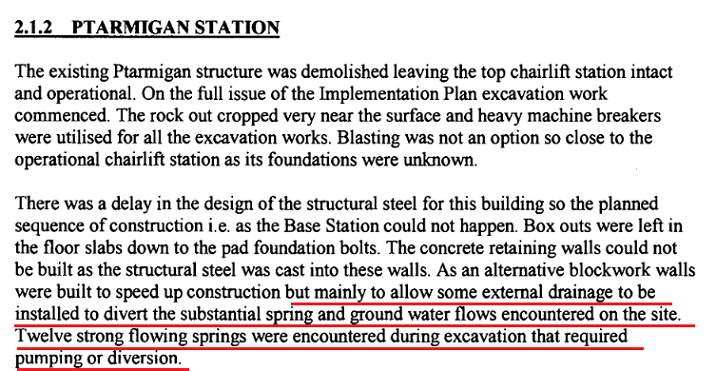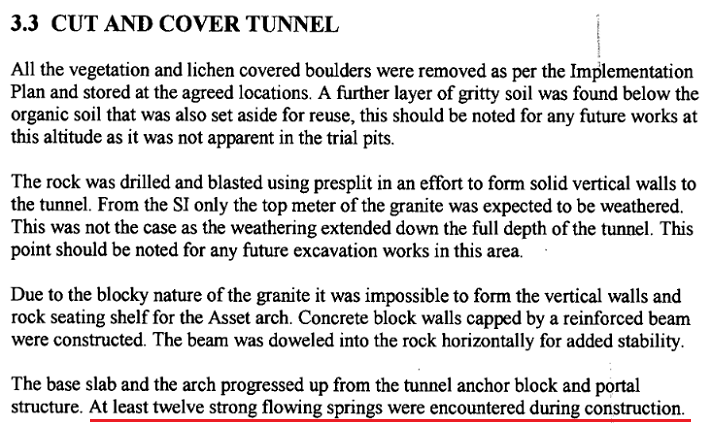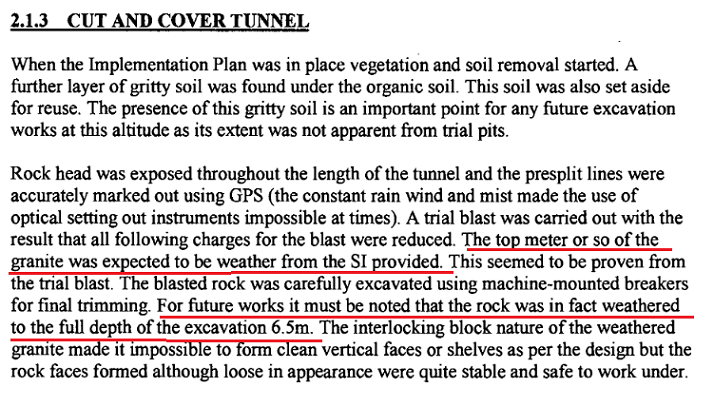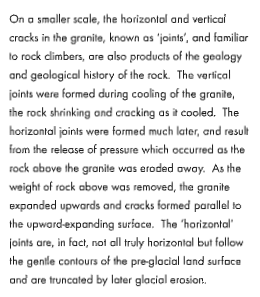Last September I described how Highlands and Islands Enterprise (HIE) released the Health and Safety file from the funicular construction nine months after I had requested it and how information within it undermined the official explanation to why the repairs to the funicular had been delayed (see here). With the recent revelations about how HIE has no money to pay for the soaring repair bill (see here), this post takes a look at the information in the Health and Safety file about ground conditions at Cairn Gorm which suggests that the funicular should never have been built and why work should now be halted.
Water, water, everywhere

This and the following extracts are from the first health and safety file (see here)

 What this shows is that the three single largest elements of the funicular construction exposed strong flowing springs, probably what most of us would call streams, which required pumping or diversion. Twenty-four of which were located right at the top of the funicular, i.e well-placed to flow down the line of the support piers.
What this shows is that the three single largest elements of the funicular construction exposed strong flowing springs, probably what most of us would call streams, which required pumping or diversion. Twenty-four of which were located right at the top of the funicular, i.e well-placed to flow down the line of the support piers.
Questions that should have been answered at the time and the information recorded in these Health & Safety files are:-
Q1. Where was that water diverted to?
Q2. Where was it resurfacing post-construction?
Q3. Did anyone take note of any new streams appearing that may have been formed by the diverted water?
Q4. If so, were these recorded for future reference?
All this raises the question of whether it is that water that has caused some of the problems that have caused the support piers to tilt? If this volume of water has travelled towards the funicular foundations it could be washing these away! There is no information publicly available to suggest that HIE investigated this issue before deciding to proceed with the repairs.
HIE has also been spending considerable sums on renovating the Ptarmigan, which I understand has been plagued by damp issues. The Health and Safety file shows that the roof was guaranteed for 20 years, raising the question whether it is one of these springs that is causing the damp to rise from below?
The condition of the bedrock

Granite, the rock which forms Cairn Gorm, is an igneous rock known for being very hard, however, that is not the full story. Depending on how it has been formed, it can be as hard as the fine crystalline Granite from Ailsa Craig used for curling stones, or, when coarse and weathered, will end up as a coarse sand as found on the beach at Loch Morlich and causes the damage to ski bases. Cairn Gorm is mostly the latter and the extent of the problem is shown in this paragraph. While most of the funicular foundations are sunk into glacial till, there is no firm rock beneath to anchor the structure.
The next screenshot also helps to explain what is happening:-

The second part of this process is known as isostatic rebound and can also be caused by the melting of the glaciers that once covered the mountain. I have found no mention of this anywhere in the H & S file and yet it should have been a major concern when designing the original build.
Now consider the interaction between these rotten interlocking blocks and the water flowing on the mountain. As an example, if you take a pallet of bricks and pour water over the top layer, it will work its way through and mostly emerge at the bottom layer. However, if you now cover the top layer of bricks with sand or soil (peat) and again pour water over that layer, the water will start to emerge in different places as the sand or soil gets washed through the bricks and starts to block the channels that it was using before.
It appears likely that same thing is happening on Cairngorm, those strong flowing springs will over time change course creating fresh streams when they re-surface!
If a full geo-technical survey had been carried out prior to the funicular project being given the go ahead, it appears likely this would have shown that Cairn Gorm was a totally unsuitable environment to construct a railway. The failure to do so was all down to HIE’s vain intent to run a funicular railway up the side of a mountain without proper consideration of all the relevant information and at any cost. Built in haste!
More recently, if a full geo-technical investigation into the reasons for the funicular failure had been carried out, then the £millions now being spent on the soaring repairs bill may not have been wasted! The funicular is basically built on unstable debris and rock which hasn’t slipped, YET!
Conclusion
HIE’s determination to bring the funicular back into service always returns to their stated belief that it underpins the Strathspey and Badenoch economy and is necessary for snowsports on Cairn Gorm. What I hope I have shown here, and with my previous seven posts “Will the repair of the Cairngorm Funicular railway work?”, is that alongside the design issues Cairn Gorm was and is a completely unsuitable and UNSTABLE environment on which to build a train line.
The unstable ground conditions don’t affect chairlifts and tows to nearly the same extent because they:-
(1) require and use far fewer piers than the funicular;
(2) cause less strain on the foundations due to their lighter construction, and,
(3) are easier and cheaper to repair or replace when necessary.
In my seventh post on “Will the repair of the funicular work” (see here) I referenced the collapse of a railway in Mexico City. Given the flow of water and the ground conditions have HIE been lucky in the past that the funicular has not collapsed causing injury or even worse, loss of life? Will they be as lucky again?

A very plausible theory backed up with good evidence, Graham. Yes, water percolation through the weathered granite should have raised concerns during the initial construction and in the investigations into the failure of the funicular structure, but amazingly it didn’t! The other factor which may play an additional role further down the track of the funicular is the glacial till on which the support piers are founded. In flatter ground glacial till can be a good base for foundations, but on slopes prone to water ingress, this glacial till will very slowly slip down the mountain – thus adding to the tilt of the piers.
As has been commented on frequently, there is no published report on what the cause of the failure of so many of the funicular piers was, so what confidence is there that the very expensive and over-budget repair work will solve the problem – NONE! If your house started to show major structural cracks would you risk all your savings to effect repairs without understanding what the cause of the structural cracks was and whether the repair design was appropriate to cure the problem? It appears that HIE and the Scottish Government did!
As someone operating a tourism business in Strathspey, I’m still amazed that HIE and the Scottish Government think that the funicular, far less the rest of the Cairngorm Mountain business, makes any significant contribution to the local economy. This myth should be put to rest once and for all.